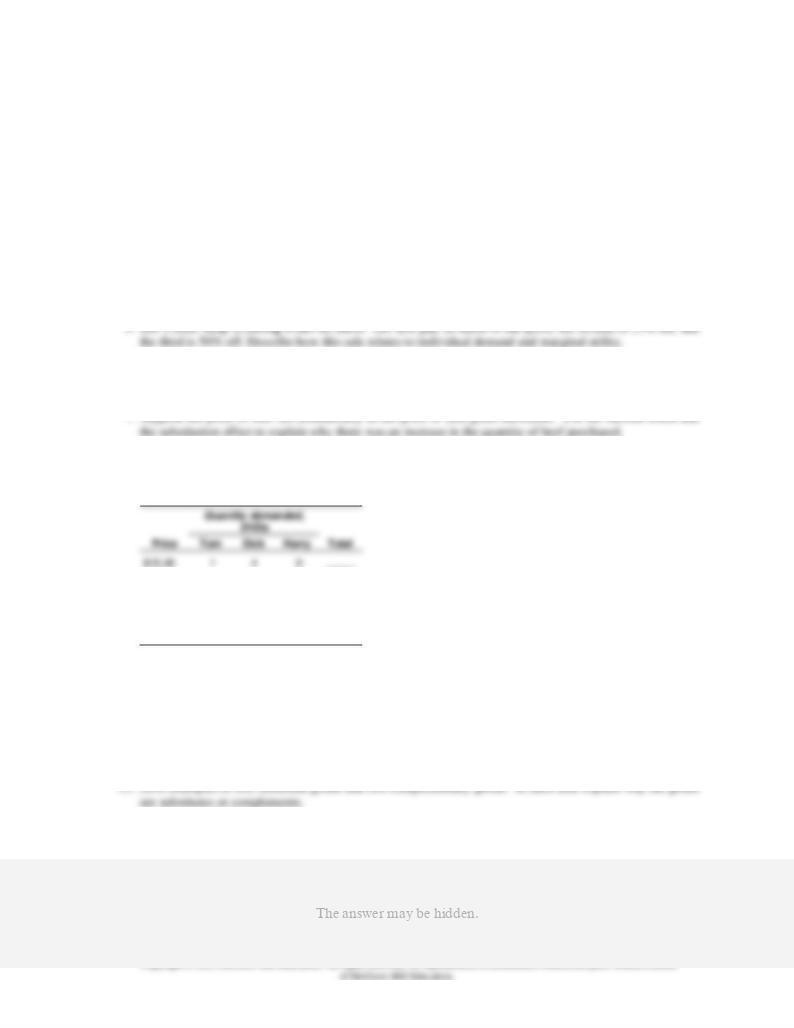
CHAPTER 3
Demand, Supply, and Market Equilibrium
A. Short-Answer, Essays, and Problems
1. Explain what is meant by a competitive market.
2. Define “demand.”
3. State the law of demand and explain why the other-things-equal assumption is critical to it.
4. Give three explanations for the law of demand.
6. Suppose a producer sells 1000 units of a product at $5 per unit one year, 2000 units at $8 the next year, and
3000 units at $10 the third year. Is this evidence that the law of demand is violated? Explain.
8. The demand schedules of three individuals (Tom, Dick, and Harry) are shown. If they are the only three
buyers of DVDs, complete the market demand schedule for DVDs. Graphically, is the market demand for
a product the horizontal or vertical sum of the individual demand schedules?
13.00
3
5
1
_____
11.00
6
6
5
_____
9.00
10
7
10
_____
7.00
15
8
16
_____
9. List five basic determinants of market demand that could cause demand to decrease.
10. List five basic determinants of market demand that could cause demand to increase.
11. Differentiate between a normal (superior) and an inferior good.
12. Explain how the prices of related goods also affect demand.
14. What effect should each of the following have upon the demand for DVDs in a competitive market?
Explain your reasoning in each case.
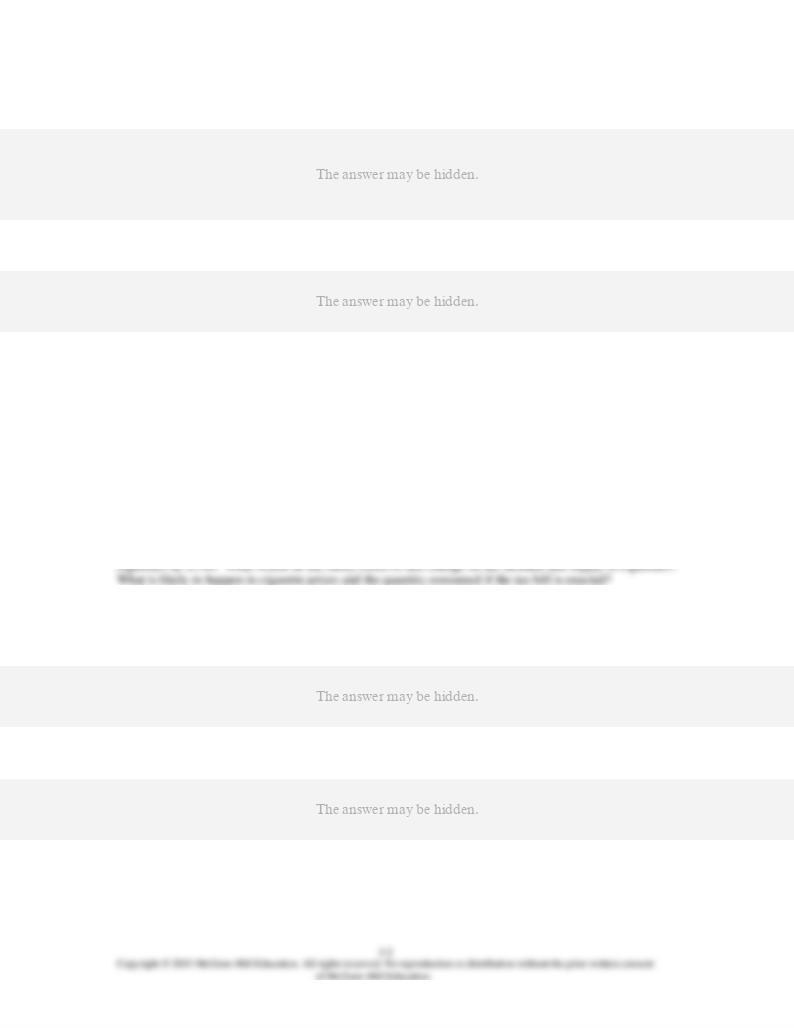
15. Evaluate how the following situations will affect the demand curve for iPods.
16. What effect should each of the following have on the demand for gasoline in a competitive market? State
what happens to demand. Explain your reasoning in each case and relate it to a demand determinant.
17. What is the difference between a change in demand and a change in quantity demanded?
18. Define “supply.”
19. Describe and give a reason for the law of supply.
20. List six basic determinants of market supply.
21. Newspaper item: “Due to lower grain prices, consumers can expect retail prices of choice beef to begin
dropping slightly this spring with pork becoming cheaper after midsummer,” the Agriculture Department
predicted. “This reflects increasing supply,” the department said. Does the statement use the term
“supply” correctly? What effects might this announcement have on consumer demand? Explain.
22. Suppose the U.S. Congress is considering passing an excise tax that would increase the price of a pack of
23. What is the difference between a change in supply and a change in quantity supplied?
24. What effect will each of the following have upon the supply of television sets in a competitive market?
Explain your reasoning in each case.
25. What effect will each of the following most likely have on the supply of corn in a competitive market?
State what happens to supply. Explain your reasoning in each case and relate it to a supply determinant.
26. Economist Jones defines an increase in supply as a decrease in the prices needed to ensure various amounts
of a good being offered for sale. Economist Brown defines an increase in supply as an increase in the
amounts that producers will offer at various possible prices. Economist Cole defines an increase in supply
as an increase in the amount firms will offer in the market which is caused by an increase in the price of the
product. Which, if any, of these is defining an increase in supply correctly? Explain.
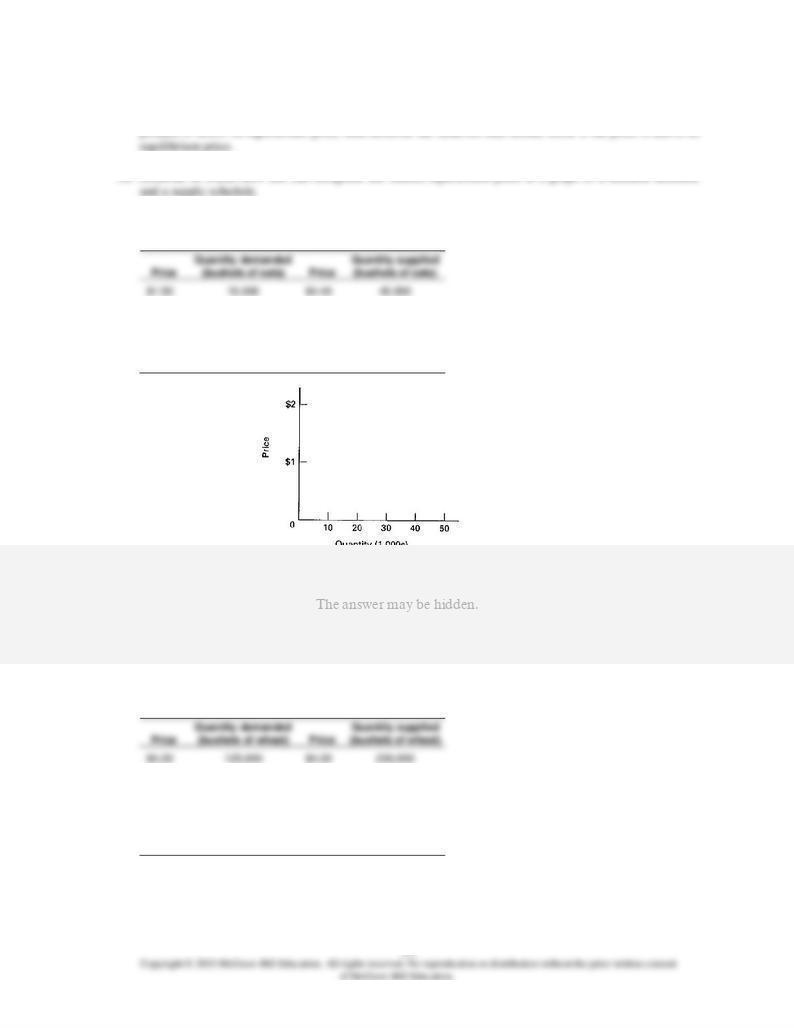
27. Assuming no government intervention, describe the market behavior that should result if the price of a
29. Using the schedules given, plot the demand curve and the supply curve on the below graph. Label the axes
and indicate for each axis the units being used to measure price and quantity. Then answer the questions.
1.40
15,000
4.20
35,000
1.30
20,000
4.00
30,000
1.20
25,000
3.80
25,000
1.10
30,000
3.60
20,000
1.00
35,000
3.20
15,000
30. Using the schedules given, plot the demand curve and the supply curve on the below graph. Label the axes
and indicate for each axis the units being used to measure price and quantity. Then answer the questions.
4.00
150,000
4.00
220,000
3.80
175,000
3.80
210,000
3.60
200,000
3.60
200,000
3.40
225,000
3.40
190,000
3.20
250,000
3.20
180,000
3.00
275,000
3.00
170,000
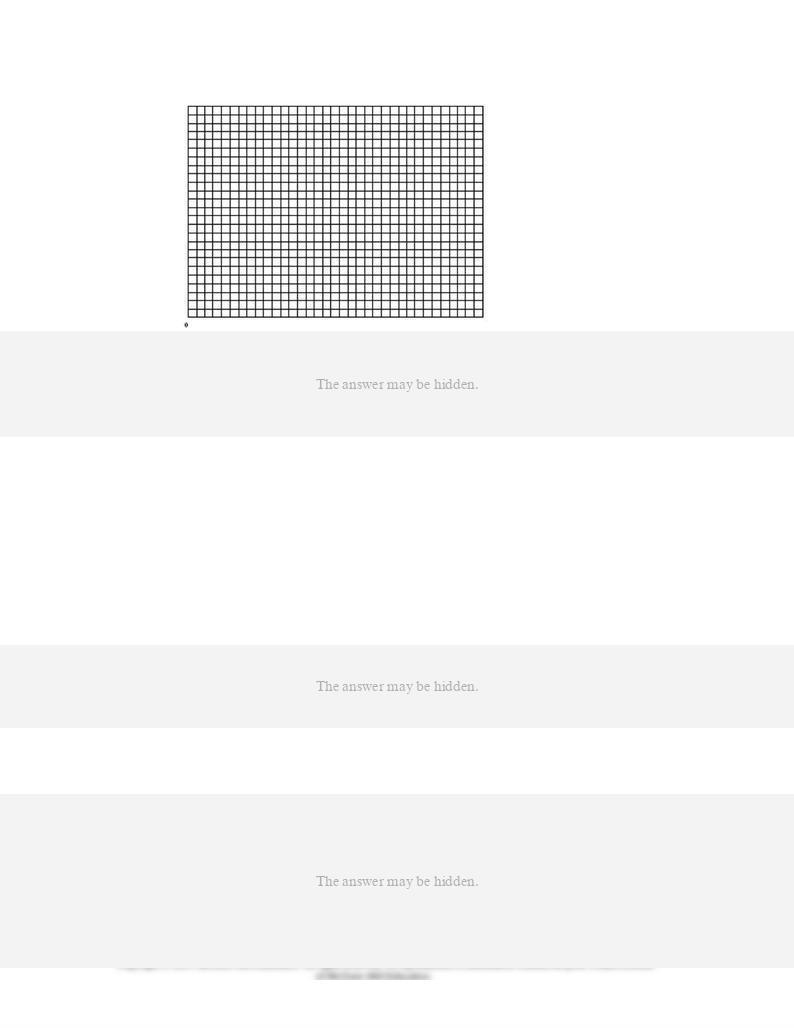
31. Is demand more important than supply in determining equilibrium price and quantity in a competitive
market? Explain.
32. (Consider This) Can ticket “scalping” be justified? Explain using economic analysis.
33. What is productive efficiency and how does it differ from allocative efficiency?
34. What are the conditions necessary to produce neither an “underallocation” nor “overallocation” of
resources?
35. In the space below each of the following, indicate the effect [increase (+), decrease (−)] on equilibrium
price (P) and equilibrium quantity (Q) of each of these changes in demand and/or supply.
36. In the spaces below each of the following, indicate the [increase (+), decrease (−), or indeterminant (?)]
on equilibrium price (P) and equilibrium quantity (Q) of each of these changes in demand and/or supply.

37. In each case below, indicate the effect [increase (+); decrease (−); indeterminant (ind)] upon equilibrium
price (P) and equilibrium quantity (Q) and illustrate the change graphically. Where you believe the effect
is indeterminant, two graphical illustrations may be necessary to demonstrate your point.
38. Given the products below and the events that affect them, indicate what happens to demand or supply, and
the equilibrium price and quantity in a competitive market. Identify the determinant of demand or supply
that causes the shift.
39. Given the products below and the events that affect them, indicate what happens to demand or supply, and
the equilibrium price and quantity in a competitive market. Identify the determinant of demand or supply
that causes the shift.
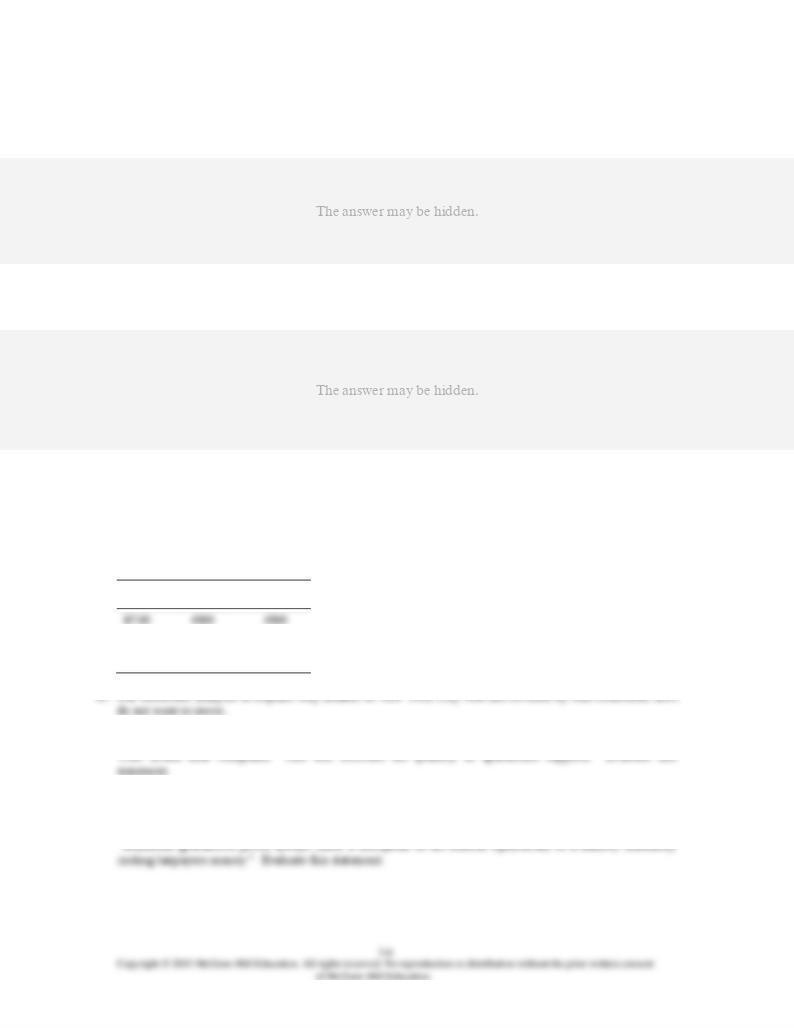
40. Given the products below and the events that affect them, indicate what happens to demand, supply,
equilibrium quantity, and equilibrium price in a competitive market. Identify the determinant of demand
and supply that causes the shifts.
41. Given the products below and the events that affect them, indicate what happens to demand, supply,
equilibrium quantity, and equilibrium price in a competitive market. Identify the determinant of demand
and supply that causes the shifts.
42. (Consider This) Suppose a salsa manufacturers sells 1 million bottles of salsa at $4 a bottle in year 1; 2
million bottles at $5 in year 2; and 3 million bottles at $6 in year 3. Do these data show that the law of
demand does not hold? Explain.
43. What is a price ceiling and what are its economic effects?
44. Use data in the table below to explain the economic effects of a price ceiling at $6, at $5, and at $4.
Price
Quantity
demanded
Quantity
supplied
6.00
5000
3500
5.00
5500
2500
4.00
6000
1500
46. The city government recently implemented a price ceiling on the amount landlords can charge for rent.
47. What is a price floor and what are its economic effects?
48. In the debate over passing a bill providing a minimum guaranteed price for corn, a congressman argued,
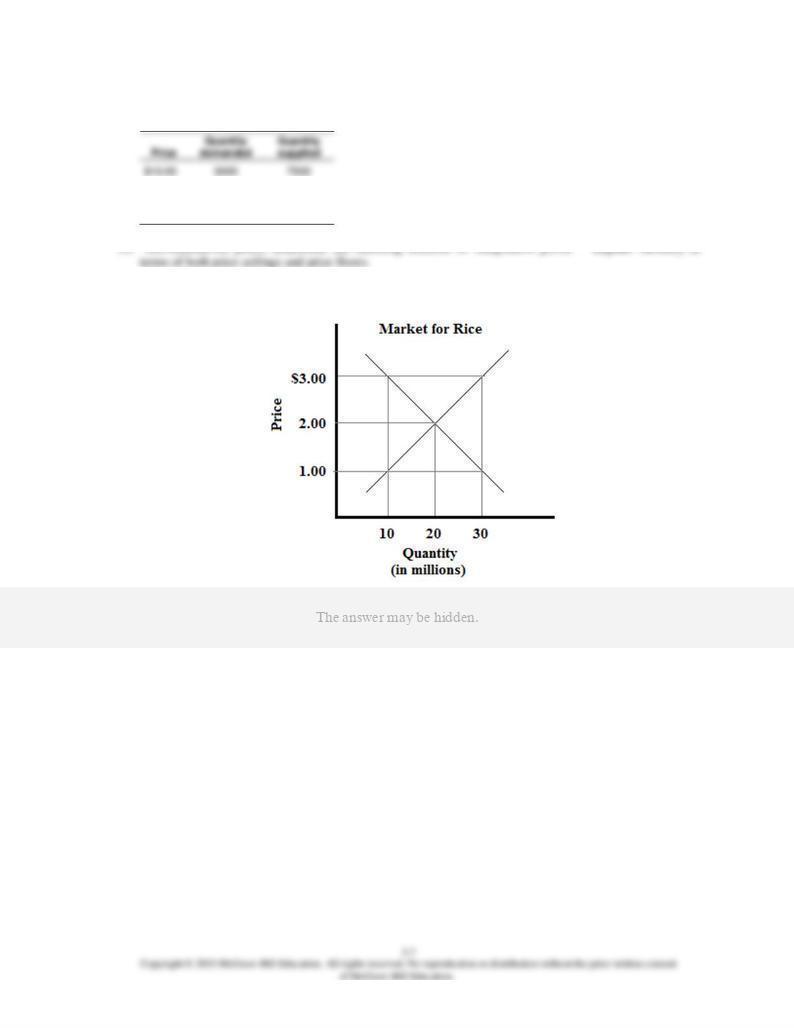
49. Use data in the following table to explain the economic effects of a price floor at $8, at $9, and at $10.
Explain the economic effects.
9.00
3500
6500
8.00
4000
5500
7.00
4500
4500
51. Answer the following questions based on the supply and demand diagram below.
52. (Last Word) Why is there a shortage of donated human organs that can be used for transplants?
53. (Last Word) Explain how a market for human organs would affect the supply curve and equilibrium price
and quantity.

B. Answers to Short-Answer, Essays, and Problems
1. Explain what is meant by a competitive market.
2. Define “demand.”
3. State the law of demand and explain why the other-things-equal assumption is critical to it.
4. Give three explanations for the law of demand:
5. Sue’s Shoe Shop is having a sale on shoes. The first pair of shoes is full price, the second is 25% off, and
the third is 50% off. Describe how this sale relates to individual demand and marginal utility.
6. Suppose a producer sells 1000 units of a product at $5 per unit one year, 2000 units at $8 the next year, and
3000 units at $10 the third year. Is this evidence that the law of demand is violated? Explain.
No. The law of demand shows the relationship between price and quantity demanded. In general, as price
falls the quantity demanded will increase. One of the assumptions, however, is that all other things are
equal or held constant. In this case, this assumption may have been violated and that is why it seems there
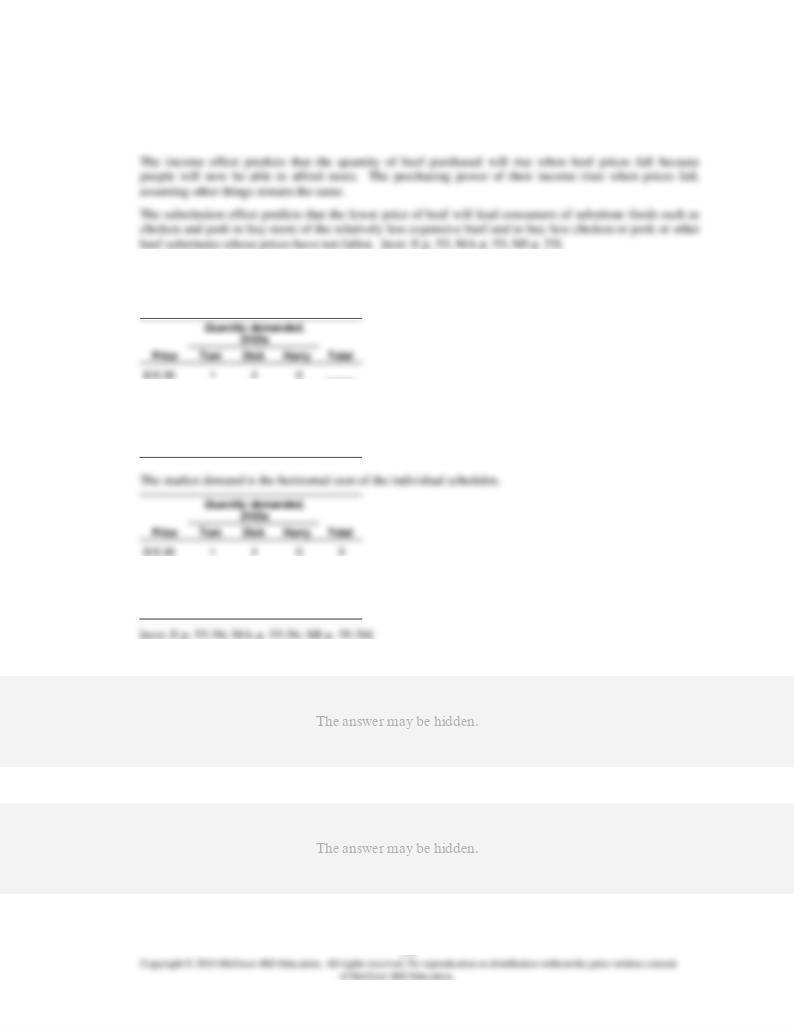
7. Suppose the price of beef fell dramatically as the price of feed grain decreased. Use the income effect and
the substitution effect to explain why there was an increase in the quantity of beef purchased.
8. The demand schedules of three individuals (Tom, Dick, and Harry) are shown. If they are the only three
buyers of DVDs, complete the market demand schedule for DVDs. Graphically, is the market demand for
a product the horizontal or vertical sum of the individual demand schedules?
13.00
3
5
1
_____
11.00
6
6
5
_____
9.00
10
7
10
_____
7.00
15
8
16
_____
13.00
3
5
1
9
11.00
6
6
5
17
9.00
10
7
10
27
7.00
15
8
16
39
9. List five basic determinants of market demand that could cause demand to decrease.
10. List five basic determinants of market demand that could cause demand to increase.
11. Differentiate between a normal (superior) and an inferior good.
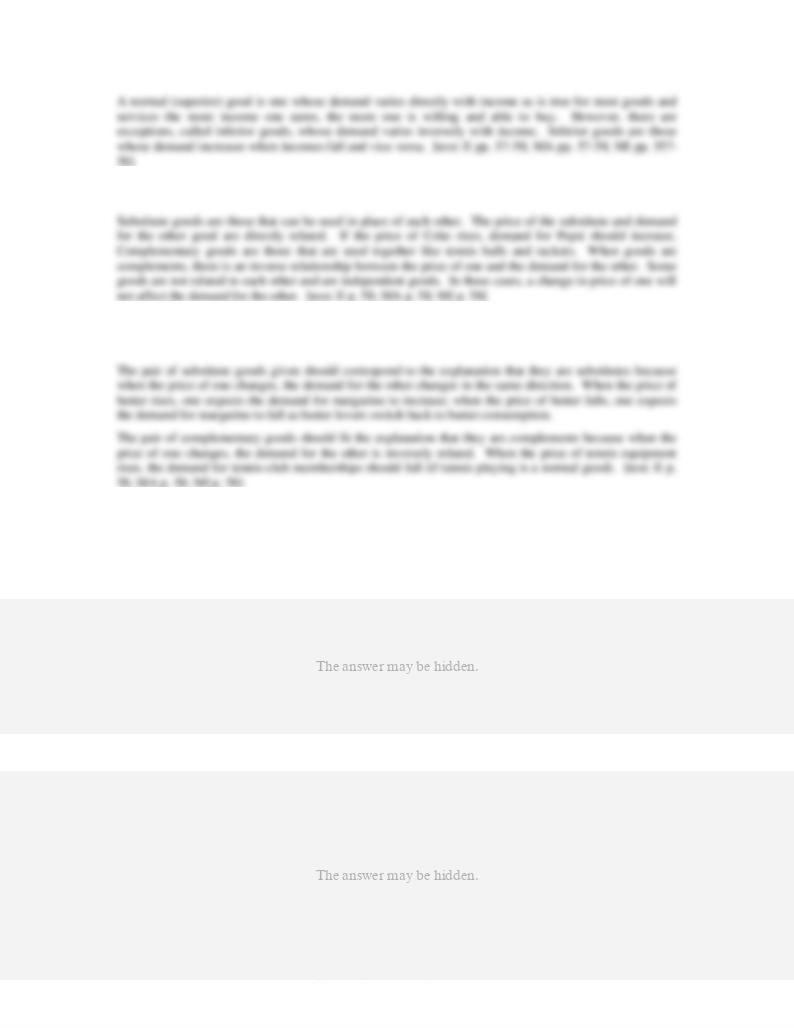
12. Explain how the prices of related goods also affect demand.
13. Give examples of two substitute goods and two complementary goods. In each case explain why the goods
are substitutes or complements.
14. What effect should each of the following have upon the demand for DVDs in a competitive market?
Explain your reasoning in each case.
(a) the development of Blue-Ray Discs that compete with DVDs
(b) an increase in population and incomes
(c) a substantial increase in the number and quality of DVD players
15. Evaluate how the following situations will affect the demand curve for iPods.
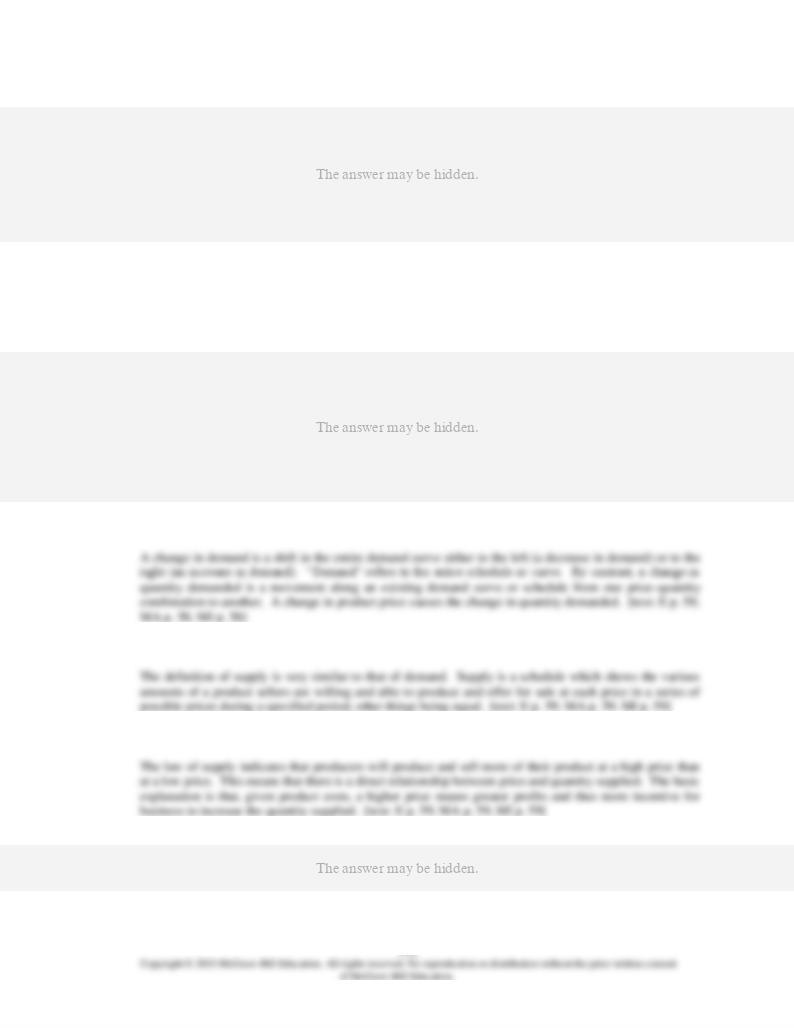
(b) These efforts raise the price of MP3s for music users that used to get their music for free from
16. What effect should each of the following have on the demand for gasoline in a competitive market? State
what happens to demand. Explain your reasoning in each case and relate it to a demand determinant.
(a) an increase in the number of cars
(b) the economy moves into a recession
(c) an increase in the price of car insurance, taxes, maintenance
17. What is the difference between a change in demand and a change in quantity demanded?
18. Define “supply.”
19. Describe and give a reason for the law of supply.
21. Newspaper item: “Due to lower grain prices, consumers can expect retail prices of choice beef to begin
dropping slightly this spring with pork becoming cheaper after midsummer,” the Agriculture Department
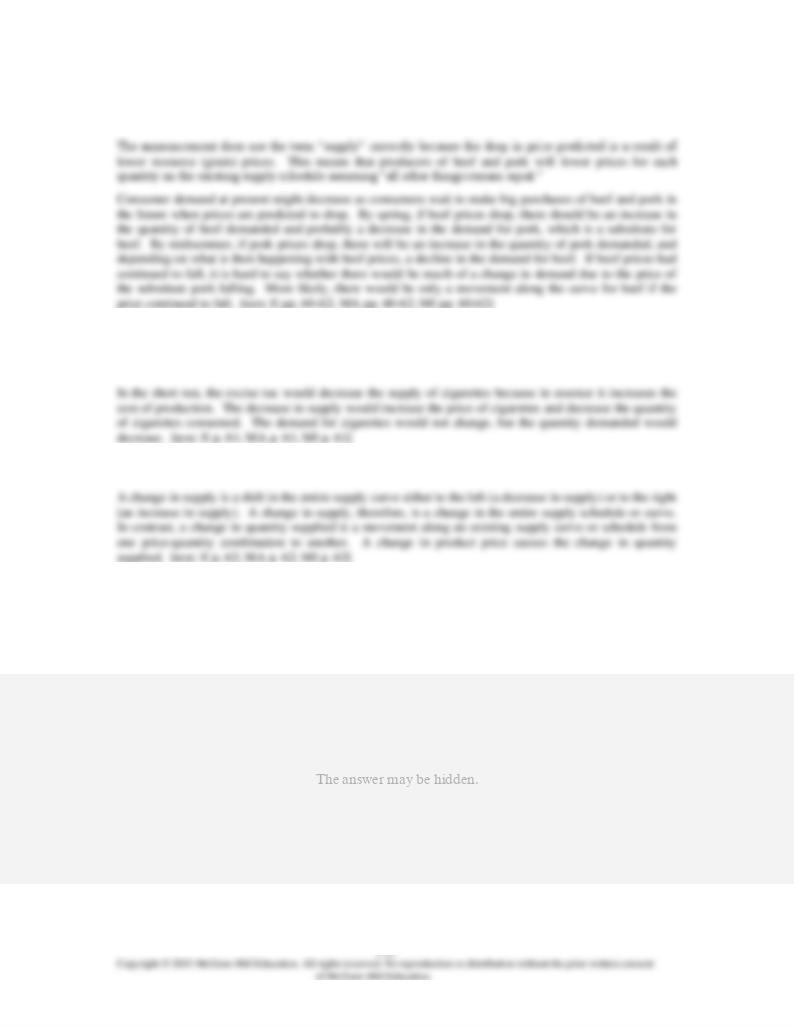
predicted. “This reflects increasing supply,” the department said. Does the statement use the term
“supply” correctly? What effects might this announcement have on consumer demand? Explain.
22. Suppose the U.S. Congress is considering passing an excise tax that would increase the price of a pack of
cigarettes by $1.00. What would be the likely effect of this change on the demand and supply of cigarettes?
What is likely to happen to cigarette prices and the quantity consumed if the tax bill is enacted?
23. What is the difference between a change in supply and a change in quantity supplied?
24. What effect will each of the following have upon the supply of television sets in a competitive market?
Explain your reasoning in each case.
(a) an increase in the price of electronic equipment used in producing television sets
(b) a decline in the number of firms producing television sets
(c) a large new tariff on imported TV sets
25. What effect will each of the following most likely have on the supply of corn in a competitive market?
State what happens to supply. Explain your reasoning in each case and relate it to a supply determinant.
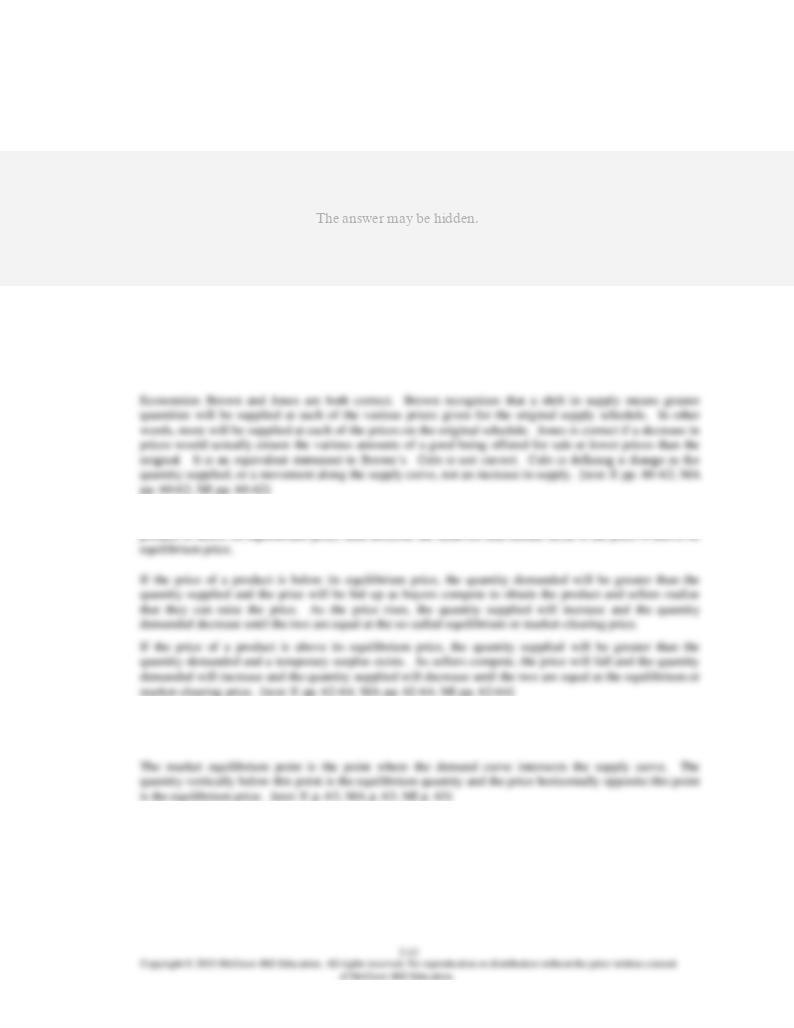
(a) the development of an improved corn seed that resists drought conditions
(b) an increase in the price of soybeans which can also be planted on land used for growing corn
(c) an increase in government payments for growing corn
26. Economist Jones defines an increase in supply as a decrease in the prices needed to ensure various amounts
of a good being offered for sale. Economist Brown defines an increase in supply as an increase in the
amounts that producers will offer at various possible prices. Economist Cole defines an increase in supply
as an increase in the amount firms will offer in the market which is caused by an increase in the price of the
product. Which, if any, of these is defining an increase in supply correctly? Explain.
27. Assuming no government intervention, describe the market behavior that should result if the price of a
28. Describe in words how one can recognize the market equilibrium point in a graph of a demand schedule
and a supply schedule.
29. Using the schedules given, plot the demand curve and the supply curve on the below graph. Label the axes
and indicate for each axis the units being used to measure price and quantity. Then answer the questions.
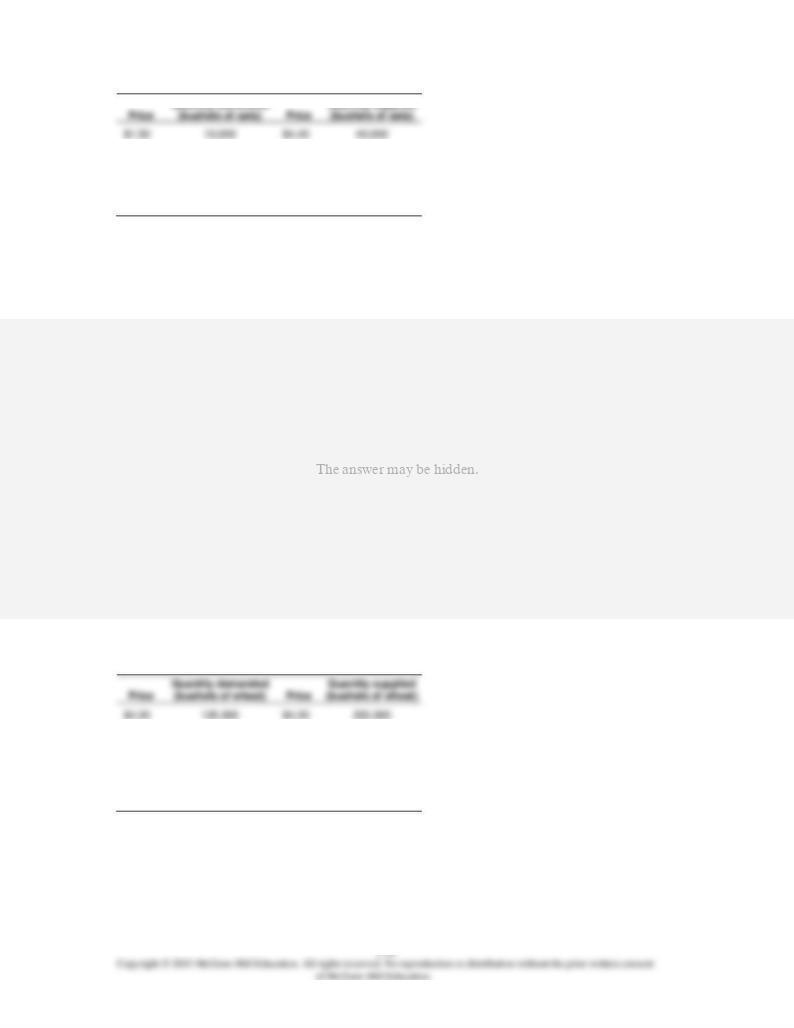
Quantity demanded
Quantity supplied
1.40
15,000
4.20
35,000
1.30
20,000
4.00
30,000
1.20
25,000
3.80
25,000
1.10
30,000
3.60
20,000
1.00
35,000
3.20
15,000
(a) Give the equilibrium price and quantity for oats.
(b) Indicate the equilibrium price and quantity on the graph by drawing lines from the intersection of the
supply and demand curves to the price and quantity axes.
(c) If the Federal government decided to support the price of oats at $1.40 per bushel, tell whether there
would be a surplus or shortage and how much it would be.
(d) Demonstrate your answer to part (c) on your graph being sure to label the quantity you designated as
30. Using the schedules given, plot the demand curve and the supply curve on the below graph. Label the axes
and indicate for each axis the units being used to measure price and quantity. Then answer the questions.
4.00
150,000
4.00
220,000
3.80
175,000
3.80
210,000
3.60
200,000
3.60
200,000
3.40
225,000
3.40
190,000
3.20
250,000
3.20
180,000
3.00
275,000
3.00
170,000
(a) Give the equilibrium price and quantity for wheat.
(b) Indicate the equilibrium price and quantity on the graph by drawing lines from the intersection of the
supply and demand curves to the price and quantity axes.
(c) If the Federal government decided to support the price of wheat at $4.00 per bushel, tell whether there
would be a surplus or shortage and how much it would be.
(d) Demonstrate your answer to part (c) on your graph being sure to label the quantity you designated as
the shortage or surplus.

31. Is demand more important than supply in determining equilibrium price and quantity in a competitive
market? Explain.
32. (Consider This) Can ticket “scalping” be justified? Explain using economic analysis.
33. What is productive efficiency and how does it differ from allocative efficiency?

34. What are the conditions necessary to produce neither an “underallocation” nor “overallocation” of
resources?
35. In the space below each of the following, indicate the effect [increase (+), decrease (−)] on equilibrium
price (P) and equilibrium quantity (Q) of each of these changes in demand and/or supply.
P Q
(a) Increase in demand, supply constant ________ ________
(b) Increase in supply, demand constant ________ ________
(c) Decrease in demand, supply constant ________ ________
36. In the spaces below each of the following, indicate the [increase (+), decrease (−), or indeterminant (?)]
on equilibrium price (P) and equilibrium quantity (Q) of each of these changes in demand and/or supply.
P Q
(a) Increase in demand, increase in supply ________ ________
(b) Increase in demand, decrease in supply ________ ________
(c) Decrease in demand, decrease in supply ________ ________

37. In each case below, indicate the effect [increase (+); decrease (−); indeterminant (ind)] upon equilibrium
price (P) and equilibrium quantity (Q) and illustrate the change graphically. Where you believe the effect
is indeterminant, two graphical illustrations may be necessary to demonstrate your point.
P Q
(a) Increase in demand, supply constant ________ ________
(b) Decrease in supply, demand constant ________ ________
(c) Decrease in demand, decrease in supply ________ ________
38. Given the products below and the events that affect them, indicate what happens to demand or supply, and
the equilibrium price and quantity in a competitive market. Identify the determinant of demand or supply
that causes the shift.
(a) Blue jeans. The wearing of blue jeans becomes less fashionable among consumers.
(b) Computers. Parts for making computers fall in price because of improvements in technology.
(c) Lettuce. El Nino produces heavy rains that destroy a significant portion of the lettuce crop.

39. Given the products below and the events that affect them, indicate what happens to demand or supply, and
the equilibrium price and quantity in a competitive market. Identify the determinant of demand or supply
that causes the shift.
(a) Digital cameras. There are improvements in the technology that increase the economic efficiency of
production.
(b) Automobiles. Consumer incomes rise as the economy moves out of recession.
(c) Beef. Chicken prices fall because of a decline in the cost of feeding chickens.
40. Given the products below and the events that affect them, indicate what happens to demand, supply,
equilibrium quantity, and equilibrium price in a competitive market. Identify the determinant of demand
and supply that causes the shifts.
(a) Calculators. More schools require students to buy and use calculators; improved productivity shortens
the time it takes to make calculators.
(b) Gasoline. Oil production declines due to a crisis in the Middle East; people take more car vacations
and drive more.
(c) New homes. The average incomes fall as the economy moves into recession; the productivity of home
construction workers and builders increases.
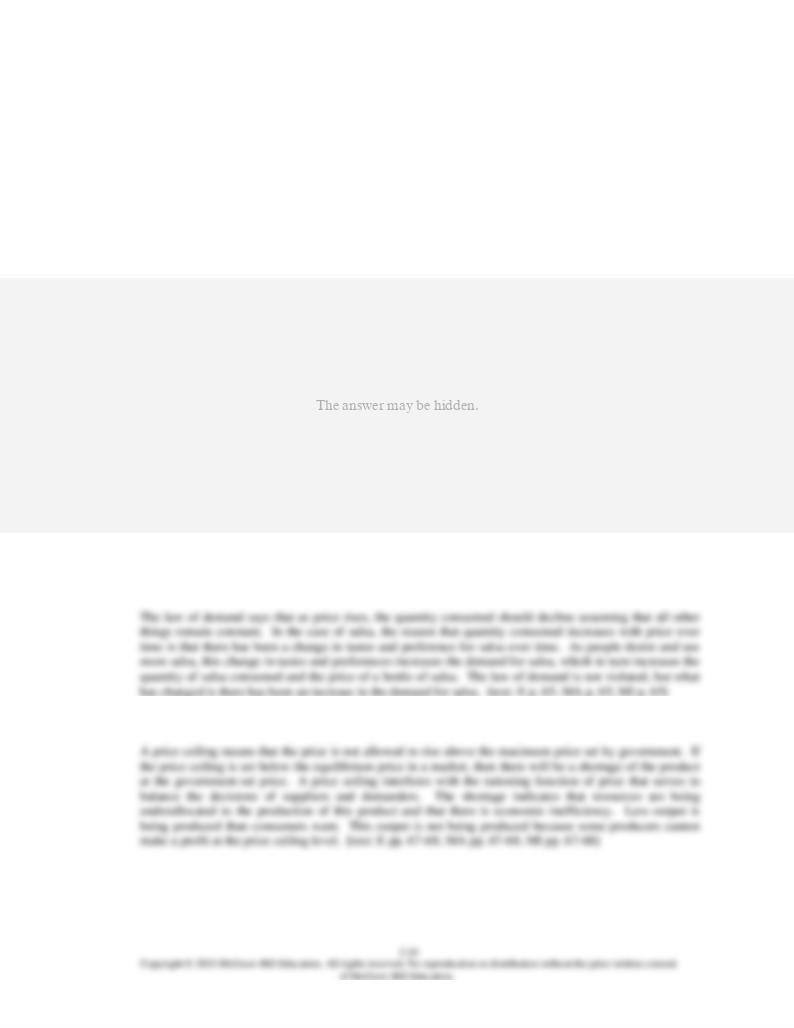
41. Given the products below and the events that affect them, indicate what happens to demand, supply,
equilibrium quantity, and equilibrium price in a competitive market. Identify the determinant of demand
and supply that causes the shifts.
(a) Home heating oil. There is a severe winter in the regions using the oil; the cost of a barrel of oil rises
for producers of home heating oil.
(b) Organic foods. People become more concerned about chemical additives in food; traditional farms are
switching to more organic methods.
(c) Film cameras. The price of digital cameras falls for consumers; there is a decline in the number of
stores selling film cameras.
(d) Bread. Many consumers adopt a low carbohydrate diet and avoid bread products; the price of flour
42. (Consider This) Suppose a salsa manufacturers sells 1 million bottles of salsa at $4 a bottle in year 1; 2
million bottles at $5 in year 2; and 3 million bottles at $6 in year 3. Do these data show that the law of
demand does not hold? Explain.
43. What is a price ceiling and what are its economic effects?
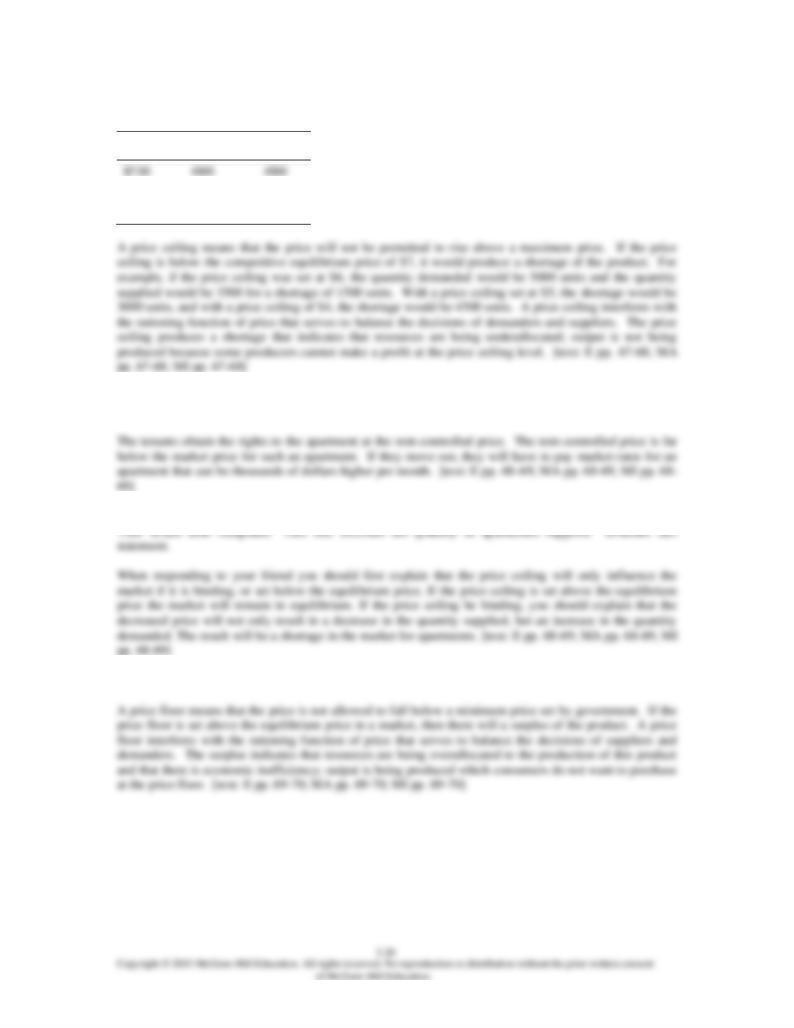
44. Use data in the table below to explain the economic effects of a price ceiling at $6, at $5, and at $4.
Price
Quantity
demanded
Quantity
supplied
6.00
5000
3500
5.00
5500
2500
4.00
6000
1500
45. Use economic analysis to explain why tenants in New York City who are covered by rent-controlled laws
do not want to move.
46. The city government recently implemented a price ceiling on the amount landlords can charge for rent.
47. What is a price floor and what are its economic effects?
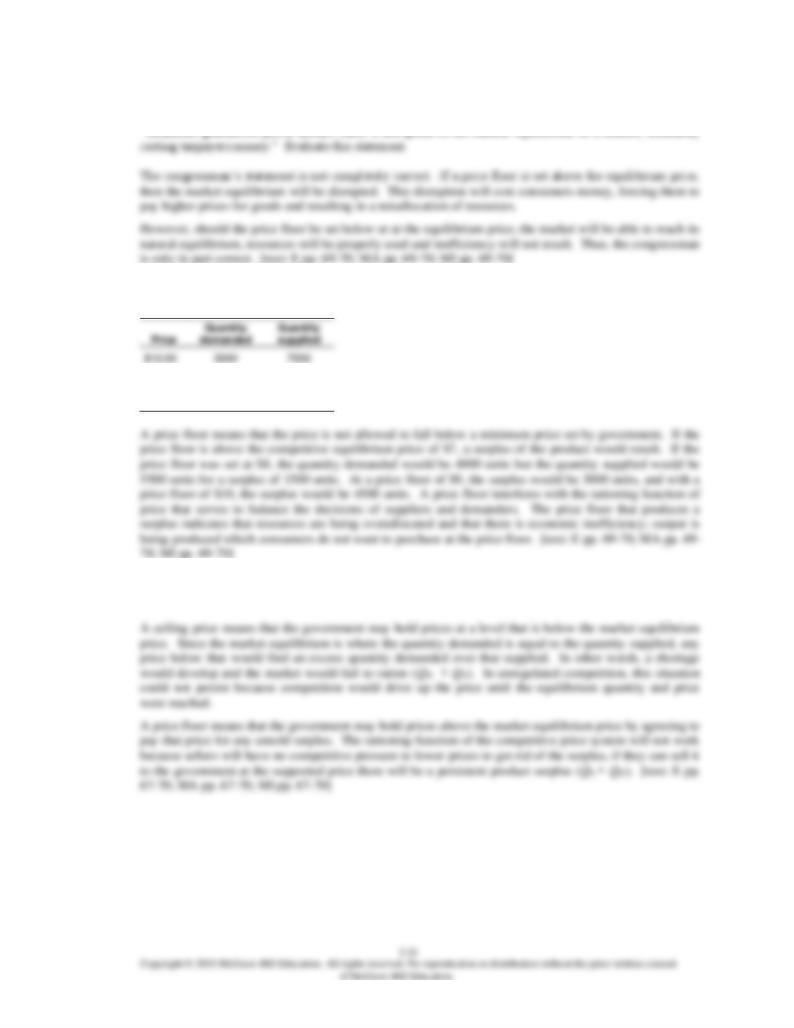
48. In the debate over passing a bill providing a minimum guaranteed price for corn, a congressman argued,
49. Use data in the following table to explain the economic effects of a price floor at $8, at $9, and at $10.
Explain the economic effects.
9.00
3500
6500
8.00
4000
5500
7.00
4500
4500
50.“Government-set prices undermine the rationing function of competitive prices.” Explain carefully in terms
of both price ceilings and price floors.
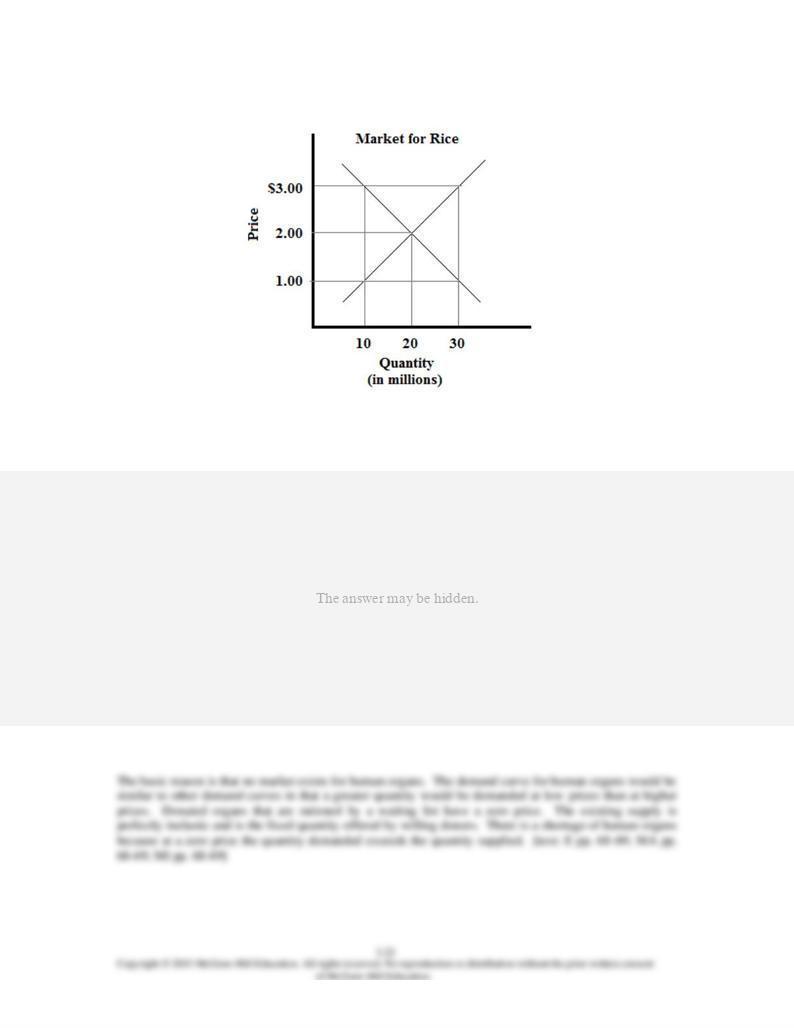
51. Answer the following questions based on the supply and demand diagram below.
(a) What is the equilibrium price and quantity in the market?
(b) Discuss the market outcome if the government were to enforce a price floor of $3.00 in the market.
(c) Discuss the market outcome if the government were to enforce a price floor of $1.00 in the market.
(d) How might the market respond to a binding price ceiling in this market?
52. (Last Word) Why is there a shortage of donated human organs that can be used for transplants?

53. (Last Word) Explain how a market for human organs would affect the supply curve and equilibrium price
and quantity.
54. Use supply and demand analysis to explain what is most likely to happen to price and quantity in a
56. What does it mean when someone says that the U.S. dollar has depreciated or the U.S. dollar has
appreciated? Give an example of each case using the euro and the U.S. dollar.
57. What will happen to the U.S. dollar price of a euro and the quantity of euros exchanged when the demand
for the euro increases, but the supply does not change? Has the U.S. dollar appreciated or depreciated?
58. What will happen to the U.S. dollar price of a euro and the quantity of euros exchanged when the demand
for the euro decreases, but the supply does not change? Has the U.S. dollar appreciated or depreciated?
59. Use supply and demand analysis to explain what is most likely to happen to the price and quantity of corn
when there is an increase in the demand for ethanol. What other effects would such a change in the corn
market have on the price of beef, the price of farmland, and the price of corn syrup?

60. What effect will each of the following have upon the equilibrium price and equilibrium quantity of laptop
computers in a competitive market? Explain your reasoning in each case.
63. Given the products and conditions below, indicate how the events affect the demand, supply, equilibrium
price and quantity of the goods.
64. Both Economist Flores and Economist Jenkins have been monitoring the cucumber market and have noted
that the equilibrium price of cucumbers and quantity of cucumbers sold have risen over the last year.
Flores and Jenkins, however, disagree about why this change has occurred. Flores holds that both supply
and demand have increased and that the shift in demand has been greater than the shift in supply. Jenkins,
however, argues that while demand has increased, supply has decreased and the shift in supply is greater
than the shift in demand. Which economist offers the most feasible theory of why the equilibrium price
and quantity of cucumbers have risen?
65. How is a preset price similar to a government-imposed price ceiling or a price floor? How is a preset price
different from a government-imposed price ceiling or price floor?
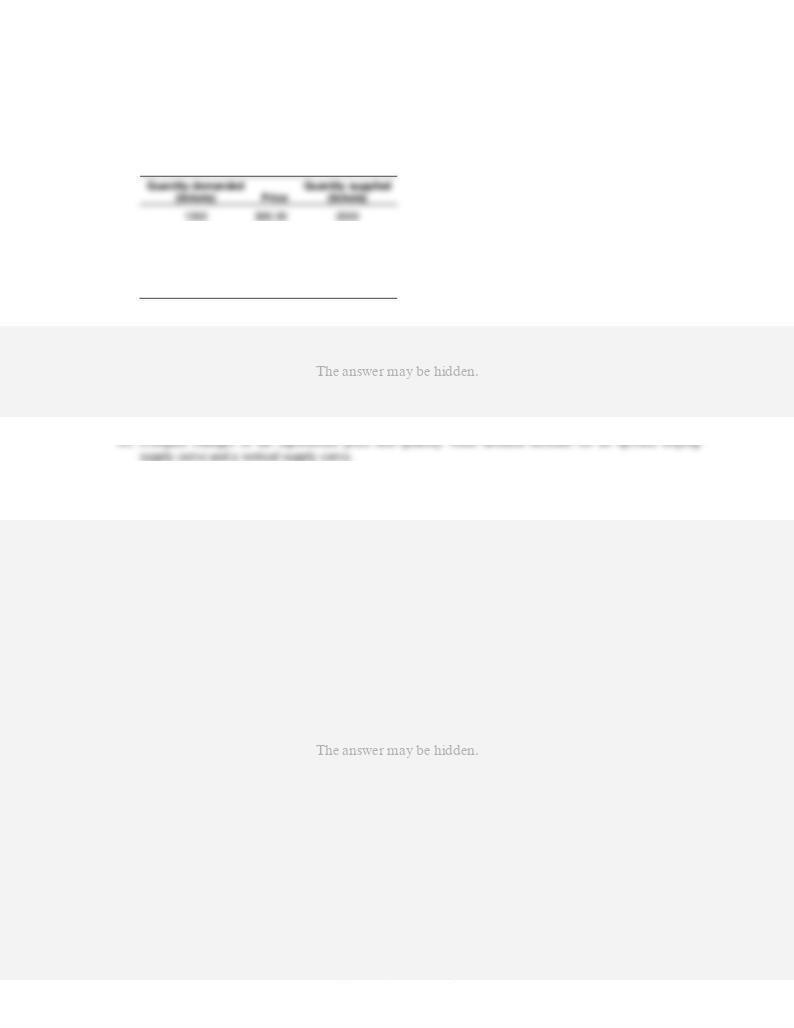
66. What condition causes a secondary market to arise?
67. The hottest, new boy band, 2Hot2Handle, has just begun their U.S. tour. The supply and demand schedules
for the local 2Hot2Handle show is below, with the arena capacity fixed at 2,000 seats.
2000
50.00
2000
3000
40.00
2000
4000
30.00
2000
5000
20.00
2000
6000
10.00
2000
Answer the following questions.
69. Give an example of a vertical supply curve and the relationship between price and quantity.
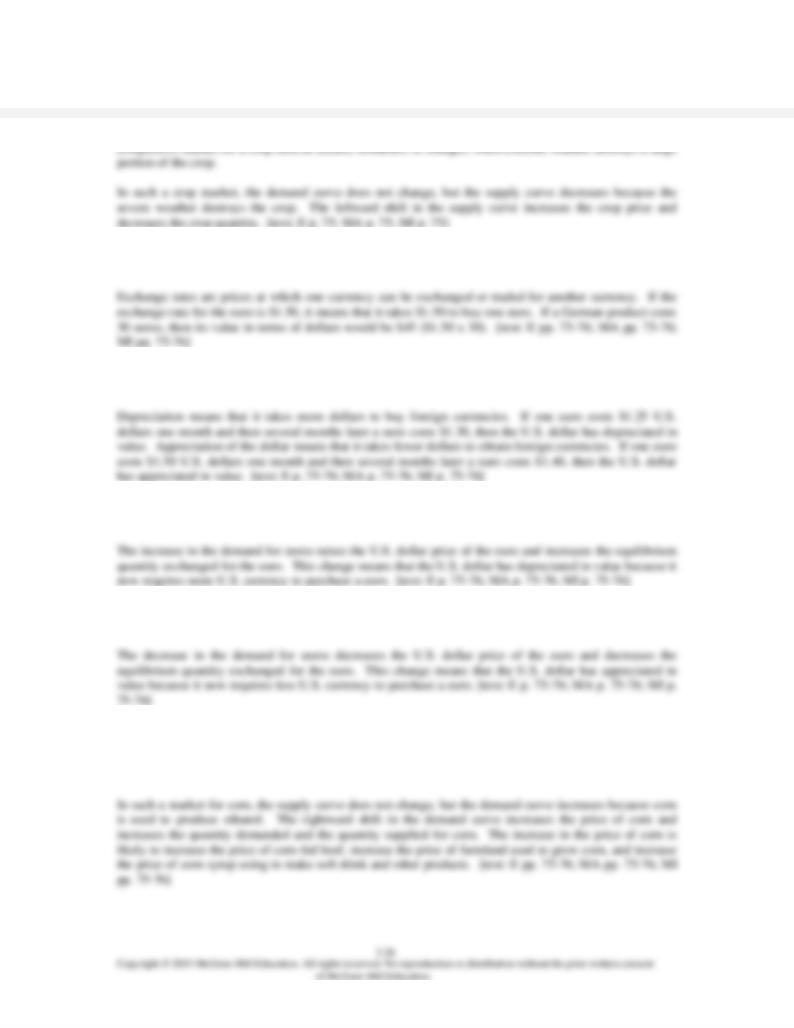
D. Answers to Appendix Questions
54. Use supply and demand analysis to explain what is most likely to happen to price and quantity in a
55. What are exchange rates? If a product cost 30 euros and the exchange rate was 1 euro = $1.50, then how
much would the product cost in terms of U.S. dollars?
56. What does it mean when someone says that the U.S. dollar has depreciated or the U.S. dollar has
appreciated? Give an example of each case using the euro and the U.S. dollar.
57. What will happen to the U.S. dollar price of a euro and the quantity of euros exchanged when the demand
for the euro increases, but the supply does not change? Has the U.S. dollar appreciated or depreciated?
58. What will happen to the U.S. dollar price of a euro and the quantity of euros exchanged when the demand
for the euro decreases, but the supply does not change? Has the U.S. dollar appreciated or depreciated?
59. Use supply and demand analysis to explain what is most likely to happen to the price and quantity of corn
when there is an increase in the demand for ethanol, which is produced using corn. What other effects
would such a change in the corn market have on the price of beef, the price of farmland, and the price of
corn syrup?
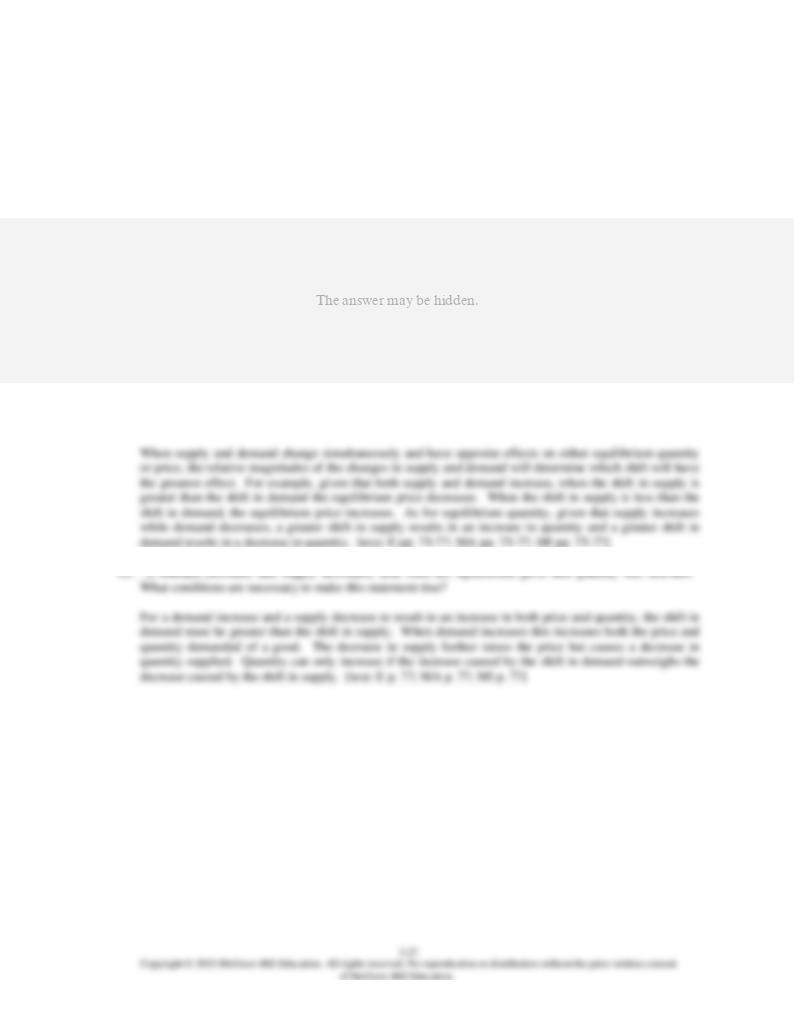
60. What effect will each of the following have upon the equilibrium price and equilibrium quantity of laptop
computers in a competitive market? Explain your reasoning in each case.
(a) the price decreases for wireless communications devices that consumers like to buy and attach to
laptop computers.
(b) fewer computer companies decide to produce laptop computers.
(c) new technology makes laptop computers cheaper to produce.
61. Explain how the relative magnitudes of changes in supply and demand can affect equilibrium price and
quantity, if supply and demand change simultaneously.

63. Given the products and conditions below, indicate how the events affect the demand, supply, equilibrium
price and quantity of the goods.
(a) Videotapes. The price of DVDs and DVD players decreases. New technology makes videotapes
easier to produce. The shift in demand is greater than shift in supply.
(b) Roses. The Valentine’s Day season has just begun for the floral industry. A new pesticide decreases
the number of flowers affected by pests. The shift in supply is greater than the shift in demand.
(c) Tomatoes. FDA publicly announces that eating tomatoes and tomato-based products can significantly
reduce one’s risk of developing cancer. An unexpected freeze late in the tomato season destroys a
significant portion of this year’s crop. The shift in supply is greater than shift in demand.
(d) Healthcare. Highly publicized malpractice cases decrease consumer confidence in healthcare
providers. Malpractice insurance premiums paid by doctors increase. The shift in demand is greater
64. Both Economist Flores and Economist Jenkins have been monitoring the cucumber market and have noted
that the equilibrium price of cucumbers and quantity of cucumbers sold have risen over the last year.
Flores and Jenkins, however, disagree about why this change has occurred. Flores holds that both supply
and demand have increased and that the shift in demand has been greater than the shift in supply. Jenkins,
however, argues that while demand has increased, supply has decreased and the shift in supply is greater
than the shift in demand. Which economist offers the most feasible theory of why the equilibrium price
and quantity of cucumbers have risen?
65. How is a preset price similar to a government-imposed price ceiling or a price floor? How is a preset price
different from a government-imposed price ceiling or price floor?
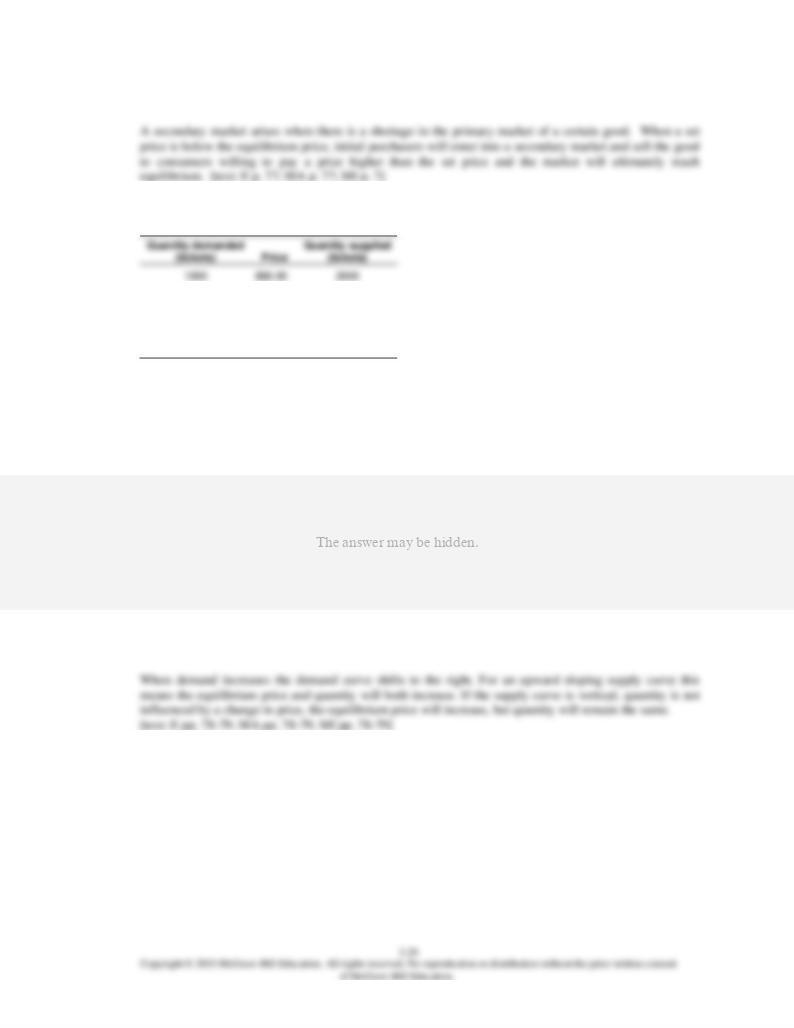
66. What condition causes a secondary market to arise?
67. The hottest, new boy band, 2Hot2Handle, has just begun their U.S. tour. The supply and demand schedules
for the local 2Hot2Handle show is below, with the arena capacity fixed at 2,000 seats.
2000
50.00
2000
3000
40.00
2000
4000
30.00
2000
5000
20.00
2000
6000
10.00
2000
Answer the following questions.
(a) Riding on their enormous popularity, 2Hot2Handle decides to set the price of tickets of all tickets at
$60. Is the market for tickets at equilibrium? If not, calculate the size of the shortage/surplus.
(b) Hoping to gain publicity by creating long lines for tickets, 2Hot2Handle decides to lower ticket prices
to $30. Is the market for tickets at equilibrium? If not, calculate the size of the shortage/surplus.
(c) Will a price of $30 be an efficient outcome? If the price of $30 does not change, how might an
68. Compare changes in the equilibrium price and quantity when demand increase for an upward sloping
supply curve and a vertical supply curve.
69. Give an example of a vertical supply curve and the relationship between price and quantity.
Some examples of a vertical supply curve include the amount of land in a given area, the number of seats in
a stadium or theatre. When the price of these goods increases the quantity supplied is difficult or impossible
to change. The amount of land in a given area is fixed and cannot increase regardless of a change in price.
[text: E pp. 78-79; MA pp. 78-79; MI pp. 78-79]

70. Use the graph provided below to answer the following questions.
(a) Draw the demand and supply curve for college football tickets at University XYZ.
(b) Suppose the football team has a significant winning streak, increasing fan’s preference to watch the
game at the stadium. Depict the change to the market. Show/Discuss changes to the equilibrium price
and quantity.
(c) Assume the University has decided to make a one-time expansion to the stadium, adding 500 seats. On
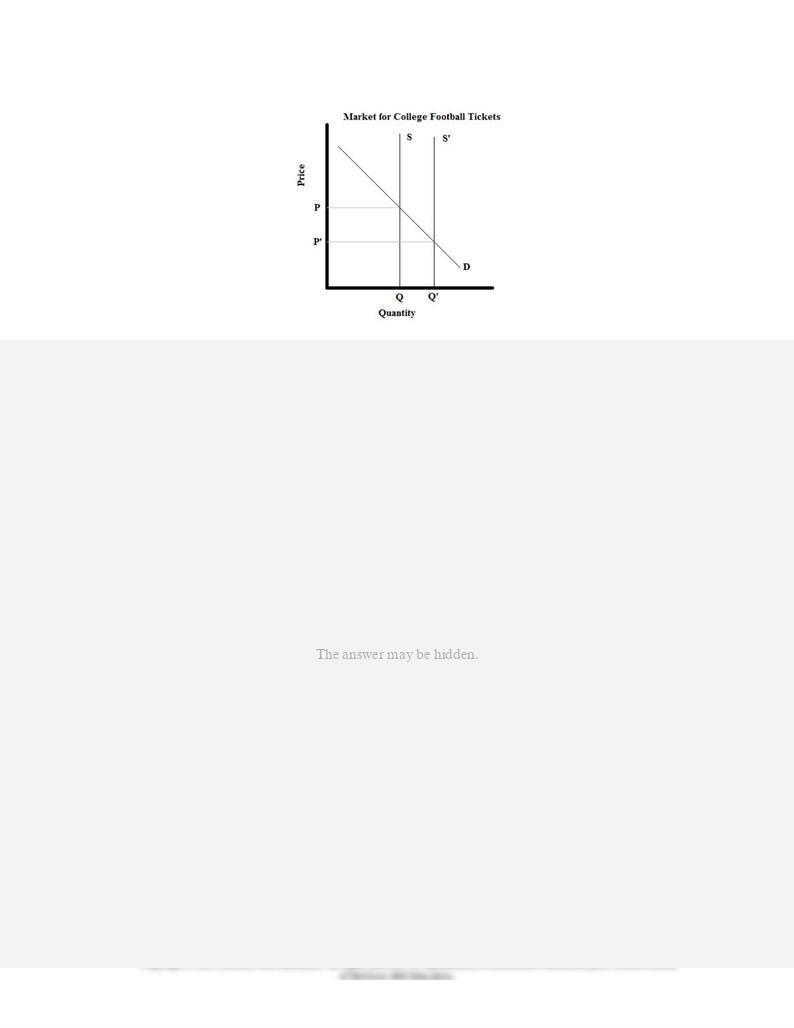
[text: E pp. 78-79; MA pp. 78-79; MI pp. 78-79]